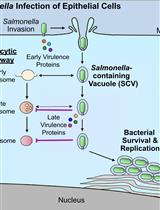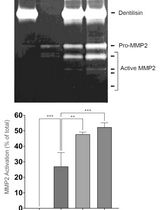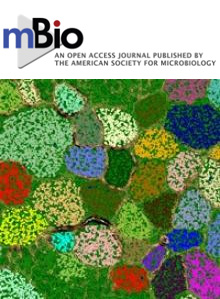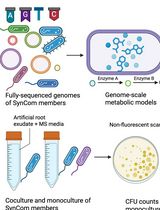- EN - English
- CN - 中文
Quantification of Bacteria Residing in Caenorhabditis elegans Intestine
秀丽隐杆线虫肠道细菌数量测定
发布: 2020年05月05日第10卷第9期 DOI: 10.21769/BioProtoc.3605 浏览次数: 5676
评审: Juan Facundo Rodriguez AyalaNeelanjan BoseAnonymous reviewer(s)

相关实验方案

细菌病原体介导的宿主向溶酶体运输的抑制:基于荧光显微镜的DQ-Red BSA分析
Mădălina Mocăniță [...] Vanessa M. D'Costa
2024年03月05日 2849 阅读

通过制备连续聚丙烯酰胺凝胶电泳和凝胶酶谱分析法纯化来自梭状龋齿螺旋体的天然Dentilisin复合物及其功能分析
Pachiyappan Kamarajan [...] Yvonne L. Kapila
2024年04月05日 2006 阅读
Abstract
Quantification of intestinal colonization by pathogenic or commensal bacteria constitute a critical part of the analysis to understand host-microbe interactions during different time points of their interplay. Here we detail a method to isolate non-pathogenic and pathogenic bacteria from C. elegans intestines, and classify gut phenotypes induced by bacterial pathogens using fluorescently-tagged bacteria. Furthermore, these methods can be used to isolate and identify new culturable bacterial species from natural microbiomes of wild nematodes.
Keywords: Host-Pathogen interactions (寄主-病原物互作)Background
In the wild, nematodes are exposed to a wide variety of bacterial and fungal communities (Frézal and Félix, 2015). Under laboratory conditions, the nematode C. elegans has been historically maintained in a single food source (Brenner, 1974). However, the worm has been challenged with various pathogens and an increasing number of non-pathogenic-bacteria of diverse nutritious quality (Garsin et al., 2003; Gracida and Eckmann, 2013; Dirksen et al., 2016; MacNeil et al., 2013; Tan et al., 1999). C. elegans embryos can be extracted from gravid hermaphrodites by using hypochlorite treatment. This procedure eliminates bacteria allowing the new generation to be exposed anew to a microbe. This advantage provides a unique framework to study host-microbe interactions. Genetic tractability of nematodes and bacteria allows to study eukaryotic (Garsin et al., 2003) and prokaryotic (Gallagher and Manoil, 2001) gene function at different time points on this dynamic interplay.
The response of C. elegans to different bacteria depends on both host defenses and bacterial virulence mechanisms (Casadevall and Pirofski, 2003; Hughes and Sperandio, 2008; Casadevall, 2017). Quantifiable physiological outputs (MacNeil et al., 2013; Samuel et al., 2016) and behavioral responses (Zhang et al., 2005; Jin et al., 2016; Palominos et al., 2017) to a variety of microbes have been reported. An important component of the study of bacteria-worm interaction is the quantification of the intestinal bacterial load as well as the ability of bacteria to colonize the animal’s gut. Rodriguez Ayala et al. (2017) explains how to isolate vegetative and resistant spores of Bacillus subtilis from worm’s guts. Palominos et al. (2017) described two independent methods to accurately quantify bacterial colonization proficiency in C. elegans. Here we expand on the methodology used in the latter.
In this protocol we first describe a method to isolate bacteria from guts of worms grown on non-pathogenic (E. coli OP50 or OP50-GFP) and pathogenic (Salmonella Typhimurium 14028, MST1 or MST1-GFP) bacteria. We then quantify the colony forming units (CFU) as measure of individual colony number present in the intestines of animals. Second, green fluorescent protein (GFP)-expressing bacteria are used to qualify the degree of intestinal colonization. All of these constitute reliable methods to measure presence of intact bacteria and degrees of colonization of C. elegans intestine. Moreover, this protocol is a simple method to measure colonization by any bacteria that is culturable or tagged with fluorescent markers (e.g., beneficial or natural bacterial cohabitants of wild nematodes). This may lead to proper identification of food sources to grow other non-cultured nematodes, as well as to study in a Petri dish how nematodes relates to their natural commensals. Finally, these methods constitute a way to study in-vivo interactions between bacteria and its living host for several generations.
Materials and Reagents
- Laboratory Labeling Tape
- Disposable Kontes® Pellet Pestle® Grinders (VWR, catalog number: KT749520-0000 )
- Corning® 0.2 μm syringe filters (Sigma-Aldrich, catalog number: CLS431215 )
- 15 ml Falcon tubes (Fisher, catalog number: 14-959-49B )
- 50 ml Falcon tubes (Fisher, catalog number: 14-432-22 )
- 1.5 ml microcentrifuge tubes (FisherbrandTM, catalog number: 05-408-129 )
- Weighing boats (FisherbrandTM, catalog number: 08-732-112 )
- Pipet tips (Fisher, catalog numbers: 02-707-401 , 02-707-415 , 02-707-436 )
- 90-mm Petri dishes (Nunc®, catalog number: Z717223-320EA )
- Microscope slides (Fisher, catalog number: 12-518-100B )
- 22 x 22 Microscope slide coverslips (VWR, catalog number: 470145-876 )
- Pasteur glass pipette (Fisher Scientific, catalog number: 13-678-20A )
- Plastic disposable graduated pipettes (FisherbrandTM, catalog number: 13-711-9BM )
- Borosilicate glass disposable rimless culture tubes (Thomas Scientific, catalog number: 99445-10 )
- C. elegans strains; for wild type use Bristol N2 strain from Caenorhabditis Genetics Center (CGC)
- E. coli OP50 and OP50-GFP can be obtained from the CGC (https://cgc.umn.edu/)
- Salmonella MST1-GFP is available upon request
- Glycerol ≥ 99.5% (Sigma-Aldrich, catalog number: G9012 )
- NaCl (Merckmillipore, catalog number 106404 )
- BD BactoTM Peptone (Fisher, catalog number: S71604 )
- GibcoTM BactoTM Tryptone (Fisher, catalog number: DF0123-17-3 )
- Streptomycin Sulfate (Thermo Fisher Scientific, catalog number: 11860038 )
- Gentamicin sulfate (Sigma-Aldrich, catalog number: G4918 )
- Ampicillin anhydrous basis (Sigma-Aldrich, catalog number: A9393 )
- BD BactoTM Agar (VWR, catalog number: 90000-760 )
- CaCl2·2H2O (Sigma-Aldrich, catalog number: C7902 )
- Cholesterol (Sigma-Aldrich, catalog number: C75209 )
- Ethyl alcohol pure ≥ 99.5% (Sigma-Aldrich, catalog number: 459836 )
- Levamisole hydrochloride ≥ 99% (Sigma-Aldrich, catalog number: 1359302 )
- K2HPO4 (Sigma-Aldrich, catalog number: RES20765 )
- KH2PO4 (Sigma-Aldrich, catalog number: 1551139 )
- MgSO4 (Sigma-Aldrich, catalog number: 230391 )
- Yeast extract (GibcoTM, catalog number: 212710 )
- Nematode Growth Medium (NGM) plates (see Recipes)
- Solid Luria-Bertani (LB) (see Recipes)
- Liquid LB (see Recipes)
- Sterile 1 M MgSO4 solution (see Recipes)
- Sterile 1 M CaCl2 (see Recipes)
- Sterile Phosphate buffer (see Recipes)
- M9 buffer (see Recipes)
- Levamisole 250 mM (stock) in M9 (see Recipes)
- M9 + Lev (M9 with 25 mM levamisole) (see Recipes)
- M9 + Lev + Ab (M9 with 25 mM levamisole with antibiotics) (see Recipes)
- 1 mM levamisole for microscopy (see Recipes)
- 87% glycerol for bacterial stocks (see Recipes)
- 2% agar for microscopy (see Recipes)
Equipment
- Hand Tally Counter (Humboldt, catalog number: H-9700 )
- Pipetman P10, P200 P1000 (Gilson, catalog numbers: F144802 , F123601 , F123602 )
- Platinum pick made as described in Wollenberg et al. (2013)
- Bunsen burner
- Autoclave
- Stirring hotplate
- Thermal block
- Refrigerated Centrifuge (Eppendorf)
- Laminar flow cabinet
- Incubator for stable temperature
- Incubator for liquid culture
- Dissecting stereoscope with fluorescence
- Freezer (-20 °C)
- 500 ml glass beaker
- 0.5 and 1 L DURAN® Original glass bottles (www.duran-bottle-system.com)
- Stirrer
- Inverted fluorescence microscope with x40 and x60 magnification, and Nomarski filters (Nikon, model: Eclipse Ti-5 )
Software
- FIJI (Schindelin et al., 2012) (FIJI is just ImageJ) Version 2.0, available at http://imagej.net(Fiji/Downloads)
- Microsoft® Excel 2015
- GraphPad Prism 6 (©Graphpad Software)
Procedure
文章信息
版权信息
© 2020 The Authors; exclusive licensee Bio-protocol LLC.
如何引用
Palominos, M. F. and Calixto, A. (2020). Quantification of Bacteria Residing in Caenorhabditis elegans Intestine. Bio-protocol 10(9): e3605. DOI: 10.21769/BioProtoc.3605.
分类
微生物学 > 微生物-宿主相互作用 > 细菌
细胞生物学 > 细胞分离和培养 > 细胞分离
您对这篇实验方法有问题吗?
在此处发布您的问题,我们将邀请本文作者来回答。同时,我们会将您的问题发布到Bio-protocol Exchange,以便寻求社区成员的帮助。
Share
Bluesky
X
Copy link










